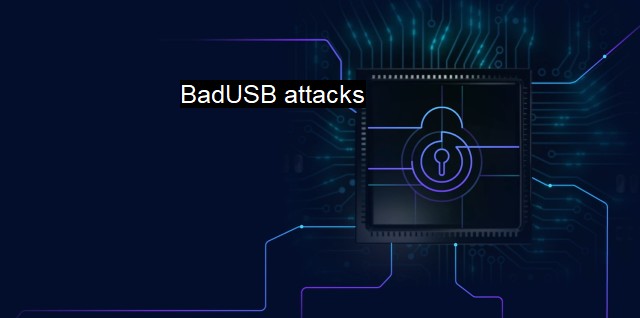What are BadUSB attacks?
The Rise of BadUSB: A Silent and Dangerous Cyber Attack on USB Devices and Network Security
In the realm of cybersecurity and antivirus protection, the innovation and sophistication of attacks are ever-evolving, requiring an ongoing effort for effective defense. One such innovation that has drawn significant attention from cyber experts around the globe is BadUSB attacks."BadUSB" refers to a type of malicious attack that capitalizes on the fundamental protocols of USB devices. The genesis of the term "BadUSB" can be traced back to a presentation at the 2014 Black Hat Conference, where researchers Karsten Nohl and Jakob Lell unveiled the theoretical framework that enables the conduct of BadUSB attacks.
a BadUSB attack involves reprogramming the firmware that controls the fundamental operations of USB devices. From basic thumb drives to high-end devices such as keyboards, mice, smartphones, and webcams that use USB for connection, BadUSB can turn nearly any USB device into a potential source of attack.
The danger of BadUSB attacks is insidious and multiple-fold. First, most antivirus solutions are designed to scan only the storage of USB devices, not the firmware. This means that once a USB device has been compromised by BadUSB, it is exceedingly difficult, if not impossible, to detect and mitigate. Standard antivirus products and even operating systems are clueless about the BadUSB attack, and they cannot prevent their system from being attacked.
Another feature of BadUSB attacks that makes it even more potent is its ability to emulate various types of devices. When plugged into a system, A BadUSB can trick the computer into believing it is another device. it can pose as a keyboard and then 'type' malicious commands into the victim's computer or even webcam to capture sensitive images or videos.
The conditions necessary for a successful BadUSB attack are shockingly straightforward. when a USB device is plugged into a system already infected by malware, it can swiftly turn that unsuspecting device into a programmed tool of harm. This presents a grave threat to the security of digital environments, as USB devices are pervasive in every type of technology we use, making them an ideal vector for cyber threats.
Another unsettling aspect of BadUSB attacks is its persistence. Once infected, the firmware denies any opportunities for simple fixes. Traditional measures like reformatting the drive or erasing its contents are found to be ineffective as they do not touch the corrupted firmware.
The complexity of mitigation against BadUSB attacks often puts common users and lesser tech-savvy enterprises in a quandary. There are some strategic measures, albeit imperfect, that can help minimize this risk. This includes using only trusted USB devices, eschewing the practice of sharing USBs, and staying mindful of the signs of an intrusion — unfamiliar command prompts, unexpected computer behavior, among others.
Enterprises can adopt stricter measures like disabling USB ports on high-risk systems or by using secure USB devices, which block unauthorized execution of a firmware upgrade. substantial investments in cybersecurity education and awareness of threats like BadUSB can bring about a marked decrease in the eventuality of such attacks.
BadUSB attacks demonstrate the rising sophistication of cyber threats in today's digital age. From leveraging unnoticed vulnerabilities to bypassing traditional antivirus measures, these attacks call for renewed vigilance and continuous technological development in cybersecurity. We must understand that in the face of innovations like BadUSB attacks, our collective lens of viewing cybersecurity threats needs to broaden, and antivirus mechanisms robustly reimagined.

BadUSB attacks FAQs
What is a badUSB attack?
A badUSB attack is a type of cybersecurity attack where an attacker uses a USB device to infiltrate and compromise a computer system. The attacker can change the firmware on the USB device to make it appear as a keyboard, which allows the attacker to issue commands to the computer system, such as installing malware or stealing sensitive information.How can I protect myself from badUSB attacks?
You can take several steps to protect yourself from badUSB attacks. First, use a reputable antivirus software that can detect and block malicious USB devices. Second, avoid plugging in USB devices from unknown or untrusted sources. Third, disable USB ports on your computer when not in use, as this can prevent malicious devices from being able to connect. Finally, keep your operating system and software up to date with the latest security patches.Can badUSB attacks be detected by antivirus software?
Some antivirus software can detect badUSB attacks, but it is not foolproof. This is because badUSB attacks can be disguised as legitimate USB devices, making them difficult to detect. However, having antivirus software installed and updated can still provide an added layer of protection against badUSB attacks.What should I do if I suspect a badUSB attack on my computer?
If you suspect a badUSB attack on your computer, immediately disconnect any USB devices from your computer and run a full scan with your antivirus software. If your antivirus software detects any malicious files or devices, follow its instructions to remove them. You should also consider changing any passwords or sensitive information that may have been compromised during the attack. Finally, report the incident to your IT department or a cybersecurity professional for further investigation.| | A | | | B | | | C | | | D | | | E | | | F | | | G | | | H | | | I | | | J | | | K | | | L | | | M | |
| | N | | | O | | | P | | | Q | | | R | | | S | | | T | | | U | | | V | | | W | | | X | | | Y | | | Z | |
| | 1 | | | 2 | | | 3 | | | 4 | | | 7 | | | 8 | | |||||||